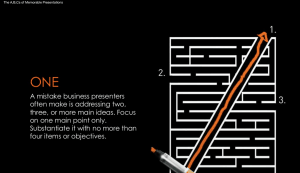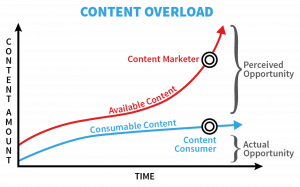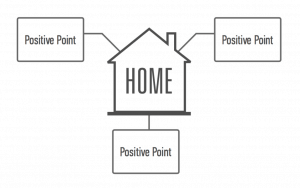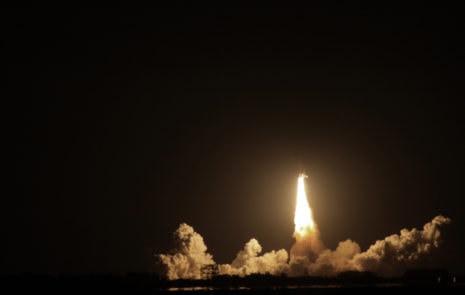
Why Marketing Messages Seem Like Potluck: Too Many Chefs
Businesses struggle to control their own messages, their own story. One reason is that big businesses often have too many chefs in the kitchen, each cooking up a separate message.
Too many chefs lead to a potluck dinner of disconnected messages that can’t break through and win audiences’ attention.
Why are too many messages a problem? Because your audiences can only receive and remember only one message at a time.
Presenting customers too many competing messages is like presenting them too many choices when it’s time to buy. It leads to confusion and paralysis. Confused customers just don’t write checks.

It’s crucial for your marketing to focus on your single most important message, also known as your home base.
Business presenters make a mistake when they present more than one main message. Audiences just don’t absorb multiple messages, as neuroscientist Dr. Carmen Simon points out. Multiple messages make your presentation forgettable.
As Simon says in The A, B, Cs of Memorable Presentations on SlideShare, audiences remember best when you present your single most important message. Then support that message with no more than 4 positive points.
When I dig into why messages proliferate in a business, often it’s because the company has not reached internal agreement on the key question about its message:
What is the single most important message you need to get across?”
Highly complex organizations may reflect an internal “mess” in their messages. In big companies, different units often create their own messages for each separate need. That may include a message for each:
- Executive
- Business unit or line of business
- Product
- Department, such as marketing and sales
- Sales territory, continent or country
- Employee communication
- Recruiting function
- Investor relations
- Lobbying
- Community relations.
But it’s a mistake to let organization structure drive your message architecture. It works better to co-create a single message in a workshop with the CEO and executive team. Once your executives have bought in to the message, they help drive it throughout the company.
A messaging co-creation process casts the CEO in the role of head chef. After all, the CEO is in change of the company’s story and message.
That’s the role Richard Branson plays as head storyteller at Virgin. Here are some of his favorite quotes on communication.
Co-creating your company’s message with a small team brings a cross-section of viewpoints to the table. So your story becomes more dimensional and more credible. When people work together to create your company’s message, it’s much more likely to be a message that has legs.
So it’s easier for your whole choir to join in and convey the message. When your executives, spokespersons and customer-facing employees all sing from the same page – your 1-Page Message MapTM – that’s a true triumph. When you have a unified message, it’s rare that your competitors can match it.

It’s more common for companies to have 3, 5, 10 or more messages, each developed in a separate organizational silo. But seen through the eyes of customers, that many messages just make a mess.
In the Age of Content Overload, a big challenge for any company to get its message to stick. Remember what you’re up against: people are bombarded by 1,500 to 30,000 messages a day, says the Business Marketing Association.
Communicators who use a 1-Page Message Map know the single most important point they need to make – it’s their home base message.

They also make their home message more believable, by backing it up with 3 or 4 positive points. Great Message Maps enable a company to tell its story as an elevator speech, in 7 seconds, and then expand the story to 2 minutes, 5 minutes, 20 minutes or more.
To help you develop your company’s message, here’s a diagram of a 1-Page Message Map. It starts with a home base, supported by 3 positive points.
Many advertising and public relations agencies prompt clients to prepare 3 or more messages for a company. The problem: that approach totally ignores the human equation baked into any communications process.
As George Bernard Shaw noted, “The single biggest problem in communication is the illusion that it has taken place.”
To make your story stick, stick with one main message. Get everybody in your company on the same page, with a 1-Page Message Map.
Related Posts
In Content Marketing & Debates, Simple Messages Win
Marketers can learn a lot about winning messages from watching political debates. In U.S. presidential debates candidates get a chance, in a free marketplace of...
Ad Age: “BtoB’s Best Marketers – George Stenitzer”
Marketing disruptive technologies takes an innovative marketing plan and persuasive content. Here’s how we marketed disruptive technology at Tellabs, winning recognition as a BtoB...
Top 10 Blogs of 2017
Here are the top 10 blogs from 2017, chosen by thousands of readers like you. They’re chock-full of ideas to make your marketing more...
7 Ideas to Make Your Content Marketing Blast Off in 2017
Start the New Year right: build a strategic launch pad to make your content marketing blast off in 2017! Use these 7 ideas to build a...





